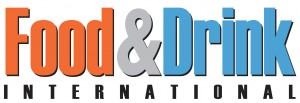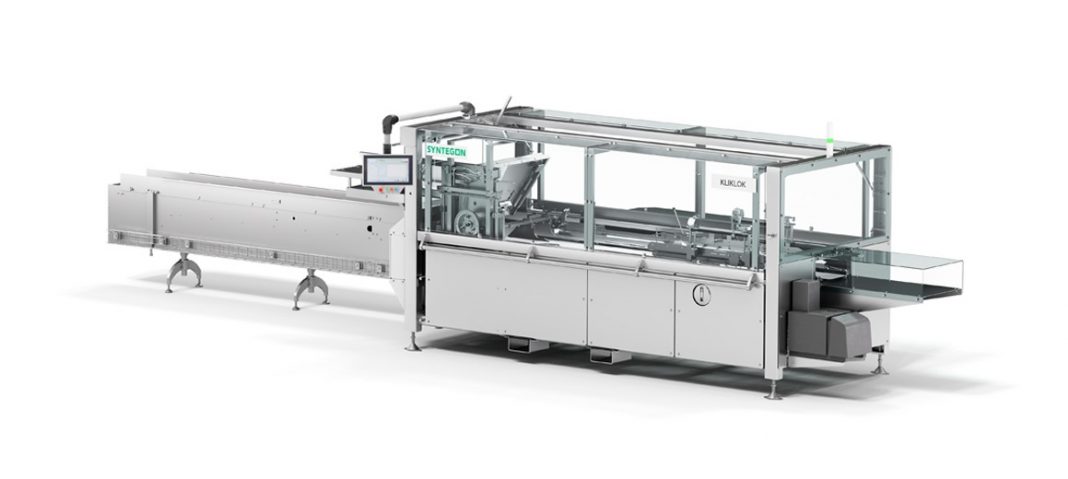From the food to personal care and the electronics industries, mid-sized businesses rely on factory automation to secure growth. This requires reasonably priced and robust technologies that optimally support their production targets.
To further its modular packaging solution portfolio, processing and packing technology partner, Syntegon, brought automation technology provider Beckhoff UK on board to co-develop a machine that could be integrated anywhere into a production line, without compromising on footprint due to bulky control cabinets.
The new BEC endload cartoner provides valuable support in those regards: as an entry-level machine, its recent upgrade includes the Beckhoff AMP servo motors instead of mechanical drive technology – a key requirement for stable processes. “Switching to servo technology allows us to ideally synchronize different drive components, securing repeatable product placement. Flexibility and reliability are key to the success of our equipment.”
Changing customer and economic requirements mean that in food manufacturing, consistency wrestles with flexibility at every turn. From adapting recipes based on changing ingredients to navigating supply chain demands and limitations, flexibility in food manufacturing is the name of the game. Yet it is not without risk; big hitters in the industry will reject products that don’t hit the correct, consistent quality every time.
Packaging is a critical part of this procedure, especially when the packaging machine is required to load the food product into the packaging before sealing. This is a critical moment in the process; tolerances for variation are extremely low, so machines must be optimised for light handling of products and flexible enough to carry out multiple functions so as not to lose valuable time in the manufacturing process.
Historically, while the main components of a cartoning solution are made to be modular, traditional machines rely on a lot of wires connected to a control cabinet, something that greatly increases the footprint of the machine while also decreasing the flexibility it can offer within the factory. Beckhoff’s expertise and dedication to its Automation Without Cabinets concept, where the control cabinet is not needed, was something Syntegon wanted its customers to benefit from.
Long-standing partnership
Beckhoff and Syntegon’s partnership goes further back than developing this new modular machine together. The two companies are global technology partners and Beckhoff partners nationally with Kliklok — part of the Syntegon Group — in the UK. The Kliklok ACE Topload Carton Former, Syntegon’s most advanced carton erector, also performed beta tests for some of Beckhoff’s most recent technologies, including the AMP8000 servo drive system.
However, as with all tests and new offerings, there were obstacles along the way. “Because Syntegon were beta testing the components, there were many changes required to accommodate continuous improvement,” said Pete Hyde, electrical and software engineering manager at Syntegon. “It was obviously being developed and designed to our needs as we were testing it. We agreed that we would be a beta tester, so we knew there would be challenges along the way. When we hit problems, we would liaise with the Beckhoff team in Germany as well as the UK. We would have regular meetings between both Beckhoff sites, and the team would make changes that we wanted to be implemented; any updates would also be done, and they would be done quickly.”
With these initial obstacles overcome, the tests’ results and feedback from ACE end-users determined the machine a win. Following this, Syntegon began building a new machine, the Basic End-Load Cartoner (BEC), from the ground up and co-developing with Beckhoff the design from an electronic angle.
The new BEC machine is a cartoner, loading products into a carton from several in-feeds — automatic loading systems that load straight into the pockets of the BEC, which then loads the product into the carton and seals with glue.
The difference between the BEC and other alternatives is that it is panelless, allowing the wiring to be much simpler than traditional packaging machines on the market, as well as offering a complete plug-and-play solution for a food manufacturer’s production processes.
AMP Technology
The BEC carton loader makes full use of Beckhoff’s AMP8000 servo drive system, which was tested on the ACE Topload Carton Former and used in the build of this machine. The system is designed to relocate the servo drive from the traditional control cabinet to the machine. The AMP8000 distributed servo drive consists of a combination of the proven AM8000 servomotors with a highly efficient servo drive, and innovative power electronics with cold switch technology that limits power loss to unprecedentedly low levels.
At the same time, the mounting space required for the electronics is reduced to an absolute minimum. The motor retains its original frame size; negating the need for a larger drive train and achieving almost the same performance data as a comparable motor/servo drive combination without attached power electronics.
EtherCAT
The BEC carton loader also reaps all the benefits of Beckhoff’s industrial Ethernet technology, EtherCAT. The EtherCAT real-time Ethernet system was developed by Beckhoff in response to the drawbacks of conventional Ethernet-based industrial networks. Before EtherCAT, most industrial-focussed network protocols had a long update or cycle times of more than 10 m/s — EtherCAT with its cycle times down to <100uS using XFC (eXtreme Fast Control Technology) and distributed clocks realises real-time synchronous data, aligning with Industrial Internet of Things (IIoT) strategies of modern machine architectures.
Beckhoff’s EtherCAT also has a flexible topology and simple line or tree structure that requires no expensive infrastructure components. This replaces the costly Ethernet star topology — where all nodes are connected to a central connection point. The result is outstanding, cost-effective performance; paired with highly dynamic servo drives enabling an integrated, fast control technology, and a simple configuration, with up to 65,535 connected devices without placing restrictions on their topology.
TwinCAT
Beckhoff’s TwinCAT 3 automation software has also been used in the BEC carton loader. With this software, it’s possible to turn a compatible PC into a powerful real-time controller. EtherCAT in combination with TwinCAT offers the foundational technologies and tools needed to implement Industry 4.0 concepts and IIoT connectivity — all via one PC-based control platform.
The Beckhoff TwinCAT real-time kernel can seamlessly pass data to the OS, Windows or BSD applications, leveraging the full power of the IPC from visualisation programs, Office programs, Microsoft/BSD (Linux) interfaces and command line executions, while also executing the IEC 61131-3 software for PLC, motion control and robotics in real-time.
Furthermore, TwinCAT saves the process data locally, on the server or in the cloud, in synchronisation with the machine cycle. TwinCAT’s IoT communication supports common protocols for cloud communication and pushes messages to smart devices for real-time monitoring and maintenance. The software is quick and easy to configure and, together with a supplied Industrial PC (IPC) as the IoT controller, establishes a seamless connection between all components of the BEC loader.
“The Beckhoff UK team regularly visited and helped us to develop the software and setup,” said Pete. “We also had regular team calls with Beckhoff Germany. Jon Hampshire (product specialist for motion at Beckhoff Automation) would visit during the commissioning time and support us to achieve our goals. If we hit an issue Jon would setup a quick Teams call with Germany, so we had a good number of Beckhoff specialists involved in the process.”
“For Syntegon, the development of this new machine also allowed us to align the components with other machines in our portfolio, simplifying our stock offering and supply chain processes,” said Pete. “For the end-user, the BEC provides easier maintenance by using fewer electronic components and connections, making the machine simpler and easier to integrate. The BEC is based on the OMAC PackML standard, so that it can easily be integrated into customers’ lines and can communicate across their network to pass PackML details, efficiency reports and Smart machine data.”
“A number of sensors have been added to detect vibration and temperature of mechanical parts which are displayed on the HMI. For ease of maintenance a full 3d model is displayed on the HMI showing all components within the machine. These will then show trends to the end-user, providing a real-time picture of how the BEC is running,” continued Pete. “For example, for a bearing within the machine, we can show trends on what its temperature is and how much vibration it is generating. From that, we can detect if the bearing is at risk of failing, or whether the chain tension is too loose or too tight.”
“Modularisation is something that we’ve been exploring with Syntegon on other machines in its portfolio, but co-developing the BEC carton loader has taken both companies’ offerings to the next level,” said Brad McEwan, business development manager at Beckhoff UK. “The way that we co-developed the electrical drawings and the software already offered modularity. Now, because of the new way the machine is wired, it is fully modular and can adapt to any production line.”
“It also allows manufacturers to see which hardware works better where, by temporarily repositioning modules rather than exhausting the capacity of the entire production line,” continued Brad. “Modules can be used to create a smaller version of the production line, allowing manufacturers to build a mental picture of what production could look like going en masse. For instance, should a food manufacturer want to begin production of a brand-new product, it is beneficial to run a test batch of this first. This also helps demonstrate how to scale up for larger production, whilst accurately determining a time to market estimation.”
Syntegon and Beckhoff are planning to extend the new machine into a range, with the BEC currently being tested and earmarked for the basic end, and future integration of more features planned to create mid-end and high-end models. This will provide a real option for true modularity within the food manufacturing industry, no matter the size.
Explore Beckhoff’s full range of solutions for the food and packaging industries at www.beckhoff.com, or contact one of the team on info@beckhoff.co.uk.


